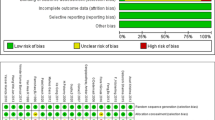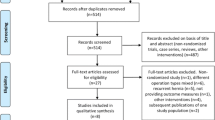Abstract
Background
Compared with open herniorrhaphy, laparoscopic herniorrhaphy can yield more favorable clinical outcomes. However, previous studies failed to give definite answer for comparison between laparoscopic inguinal hernia repair approaches. This study aimed to systematically determine the differences in recurrence rate, duration of return to work, pain, surgery duration, and duration of hospital stay between transabdominal preperitoneal (TAPP) and totally extraperitoneal (TEP) approach for inguinal hernia.
Methods
PubMed, Embase, and Cochrane Library (including the Cochrane Central Register of Controlled Trials) abstracts up to September 2017 were searched for randomized controlled trials (RCTs) comparing TAPP or TEP hernia repairing. The hernia recurrence rate, time to return to work, analgesic consumption, surgery duration, hospital stay, and the pain score were recorded with subgroup analysis of the hernia type.
Results
Sixteen RCTs that randomized 1519 patients with hernia into TEP and TAPP repair groups were analyzed in this study. The results revealed that TEP repair resulted in shorter hospital stay of primary cases (MD − 0.87, 95% CI − 1.67 to − 0.07) but was associated with a longer operative duration in recurrent hernia group (MD 3.35, 95% CI 0.16 − 6.54).
Conclusions
TEP and TAPP have their own advantages. TEP repair reduces short-term postoperative pain more effectively than TAPP repair and results in shorter hospital stay of primary cases. In contrast, TAPP repair is correlated with shorter surgery duration. These findings show that shared decision-making regarding both approaches of laparoscopic hernia repair may be needed.





Similar content being viewed by others
References
Schultz L, Graber J, Pietrafitta J, Hickok D (1990) Laser laparoscopic herniorraphy: a clinical trial preliminary results. J Laparoendosc Surg 1:41–45
Bittner R, Schwarz J (2012) Inguinal hernia repair: current surgical techniques. Langenbeck’s Arch Surg 397:271–282
Pokorny H, Klingler A, Schmid T, Fortelny R, Hollinsky C, Kawji R, Steiner E, Pernthaler H, Függer R, Scheyer M (2008) Recurrence and complications after laparoscopic versus open inguinal hernia repair: results of a prospective randomized multicenter trial. Hernia 12:385–389
Bansal VK, Misra MC, Babu D, Victor J, Kumar S, Sagar R, Rajeshwari S, Krishna A, Rewari V (2013) A prospective, randomized comparison of long-term outcomes: chronic groin pain and quality of life following totally extraperitoneal (TEP) and transabdominal preperitoneal (TAPP) laparoscopic inguinal hernia repair. Surg Endosc 27:2373–2382
Ciftci F, Abdulrahman I, Ibrahimoglu F, Kilic G (2015) Early-stage quantitative analysis of the effect of laparoscopic versus conventional inguinal hernia repair on physical activity. Chirurgia 110:451–456
Dedemadi G, Sgourakis G, Karaliotas C, Christofides T, Kouraklis G, Karaliotas C (2006) Comparison of laparoscopic and open tension-free repair of recurrent inguinal hernias: a prospective randomized study. Surg Endosc 20:1099–1104
Gong K, Zhang N, Lu Y, Zhu B, Zhang Z, Du D, Zhao X, Jiang H (2011) Comparison of the open tension-free mesh-plug, transabdominal preperitoneal (TAPP), and totally extraperitoneal (TEP) laparoscopic techniques for primary unilateral inguinal hernia repair: a prospective randomized controlled trial. Surg Endosc 25:234–239
Hamza Y, Gabr E, Hammadi H, Khalil R (2010) Four-arm randomized trial comparing laparoscopic and open hernia repairs. Int J Surg 8:25–28
Mesci A, Korkmaz B, Dinckan A, Colak T, Balci N, Ogunc G (2012) Digital evaluation of the muscle functions of the lower extremities among inguinal hernia patients treated using three different surgical techniques: a prospective randomized study. Surg Today 42:157–163
Sharma D, Yadav K, Hazrah P, Borgharia S, Lal R, Thomas S (2015) Prospective randomized trial comparing laparoscopic transabdominal preperitoneal (TAPP) and laparoscopic totally extra peritoneal (TEP) approach for bilateral inguinal hernias. Int J Surg 22:110–117
McCormack K, Wake BL, Fraser C, Vale L, Perez J, Grant A (2005) Transabdominal pre-peritoneal (TAPP) versus totally extraperitoneal (TEP) laparoscopic techniques for inguinal hernia repair: a systematic review. Hernia 9:109–114
Wake BL, McCormack K, Fraser C, Vale L, Perez J, Grant AM (2005) Transabdominal pre-peritoneal (TAPP) vs totally extraperitoneal (TEP) laparoscopic techniques for inguinal hernia repair. Cochrane database of systematic reviews (Online): CD004703
Wei FX, Zhang YC, Han W, Zhang YL, Shao Y, Ni R (2015) Transabdominal preperitoneal (TAPP) versus totally extraperitoneal (TEP) for laparoscopic hernia repair: a meta-analysis. Surg Laparosc Endosc Percutan Tech 25:375–383
Moher D, Liberati A, Tetzlaff J, Altman DG (2009) Preferred reporting items for systematic reviews and meta-analyses: the PRISMA statement. PLoS Med 6:e1000097
Hozo SP, Djulbegovic B, Hozo I (2005) Estimating the mean and variance from the median, range, and the size of a sample. BMC Med Res Methodol 5:13
Higgins JP, Thompson SG, Deeks JJ, Altman DG (2003) Measuring inconsistency in meta-analyses. BMJ 327:557–560
Wolf FM (1986) Meta-analysis: quantitative methods for research synthesis. Sage, London
Bansal VK, Krishna A, Manek P, Kumar S, Prajapati O, Subramaniam R, Kumar A, Kumar A, Sagar R, Misra MC (2017) A prospective randomized comparison of testicular functions, sexual functions and quality of life following laparoscopic totally extra-peritoneal (TEP) and trans-abdominal pre-peritoneal (TAPP) inguinal hernia repairs. Surg Endosc 31:1478–1486
Butler RE, Burke R, Schneider JJ, Brar H, Lucha PA Jr (2007) The economic impact of laparoscopic inguinal hernia repair: results of a double-blinded, prospective, randomized trial. Surg Endosc 21:387–390
Gunal O, Ozer S, Gurleyik E, Bahcebasi T (2007) Does the approach to the groin make a difference in hernia repair? Hernia 11:429–434
Jeelani S, Ahmad MS, Dar HM, Abass MF, Mushtaq A, Ali U (2015) A comparative study of transabdominal preperitoneal verses totally extra-peritoneal mesh repair of inguinal hernia. Appl Med Res 1:57–61
Krishna A, Misra MC, Bansal VK, Kumar S, Rajeshwari S, Chhabra A (2012) Laparoscopic inguinal hernia repair: transabdominal preperitoneal (TAPP) versus totally extraperitoneal (TEP) approach: a prospective randomized controlled trial. Surg Endosc 26:639–649
Schrenk P, Woisetschlager R, Rieger R, Wayand W (1996) Prospective randomized trial comparing postoperative pain and return to physical activity after transabdominal preperitoneal, total preperitoneal or Shouldice technique for inguinal hernia repair. Br J Surg 83:1563–1566
Wang WJ, Chen JZ, Fang Q, Li JF, Jin PF, Li ZT (2013) Comparison of the effects of laparoscopic hernia repair and lichtenstein tension-free hernia repair. J Laparoendosc Adv Surg Tech 23:301–305
Zhu Q, Mao Z, Yu B, Jin J, Zheng M, Li J (2009) Effects of persistent CO2 insufflation during different laparoscopic inguinal hernioplasty: a prospective, randomized, controlled study. J Laparoendosc Adv Surg Tech 19:611–614
Sterne JA, Sutton AJ, Ioannidis JP, Terrin N, Jones DR, Lau J, Carpenter J, Rucker G, Harbord RM, Schmid CH, Tetzlaff J, Deeks JJ, Peters J, Macaskill P, Schwarzer G, Duval S, Altman DG, Moher D, Higgins JP (2011) Recommendations for examining and interpreting funnel plot asymmetry in meta-analyses of randomised controlled trials. BMJ 343:d4002
Drake R, Vogl AW, Mitchell AW (2012) Gray’s basic anatomy E-book: with STUDENT CONSULT online access. Elsevier Health Sciences, New York
Snell RS (2011) Clinical anatomy by regions. Lippincott Williams & Wilkins, Baltimore
Mouton WG, Bessell JR, Otten KT, Maddern GJ (1999) Pain after laparoscopy. Surg Endosc 13:445–448
Bracale U, Melillo P, Pignata G, Salvo ED, Rovani M, Merola G, Pecchia L (2012) Which is the best laparoscopic approach for inguinal hernia repair: TEP or TAPP? A systematic review of the literature with a network meta-analysis. Surg Endosc 26:3355–3366
Dedemadi G, Kalaitzopoulos I, Loumpias C, Papapanagiotou A, Karaliotas C, Lyra S, Papatheodorou A, Sgourakis G (2014) Recurrent inguinal hernia repair: what is the evidence of case series? A meta-analysis and metaregression analysis. Surg Laparosc Endosc Percutan Tech 24:306–317
Bittner R, Arregui ME, Bisgaard T, Dudai M, Ferzli GS, Fitzgibbons RJ, Fortelny RH, Klinge U, Kockerling F, Kuhry E, Kukleta J, Lomanto D, Misra MC, Montgomery A, Morales-Conde S, Reinpold W, Rosenberg J, Sauerland S, Schug-Pass C, Singh K, Timoney M, Weyhe D, Chowbey P (2011) Guidelines for laparoscopic (TAPP) and endoscopic (TEP) treatment of inguinal hernia [International Endohernia Society (IEHS)]. Surg Endosc 25:2773–2843
Kukleta JF (2006) Causes of recurrence in laparoscopic inguinal hernia repair. J Minim Access Surg 2:187–191
Pikoulis E, Daskalakis P, Psallidas N, Karavokyros I, Stathoulopolos A, Godevenos D, Leppaniemi A, Tsatsoulis P (2005) Marlex mesh Prefix plug hernioplasty retrospective analysis of 865 operations. World J Surg 29:231–234
Author information
Authors and Affiliations
Contributions
L-SC identified evidence systematically, critically appraised the included articles, acquired the data, managed data, and drafted the first version of manuscript. W-CC identified evidence systematically, critically appraised the included articles, interpreted the result of analysis, and critically revised the manuscript. Y-NK designed the study, identified evidence systematically, critically appraised the included articles, analyzed the data, interpreted the result of analysis, critically revised the manuscript, and supervised research. C-CW identified evidence systematically, and critically reviewed the manuscript. L-WT proposed the study, critically reviewed the manuscript. M-ZL interpreted the result of analysis, interpreted the result of analysis, critically reviewed the manuscript, and supervised research.
Corresponding authors
Ethics declarations
Disclosures
Li-Siou Chen, Wei-Chieh Chen, Yi-No Kang, Chien-Chih Wu, Long-Wen Tsai, and Min-Zhe Liu have no conflicts of interest or financial ties to disclose.
Electronic supplementary material
Below is the link to the electronic supplementary material.
Rights and permissions
About this article
Cite this article
Chen, LS., Chen, WC., Kang, YN. et al. Effects of transabdominal preperitoneal and totally extraperitoneal inguinal hernia repair: an update systematic review and meta-analysis of randomized controlled trials. Surg Endosc 33, 418–428 (2019). https://doi.org/10.1007/s00464-018-6314-x
Received:
Accepted:
Published:
Issue Date:
DOI: https://doi.org/10.1007/s00464-018-6314-x




